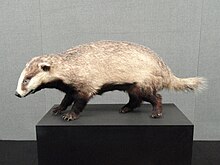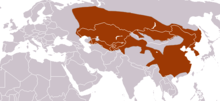Asian badger
The Asian badger (Meles leucurus), also known as the sand badger is a species of badger native to China, Kazakhstan, the Korean Peninsula and Russia.
| Asian badger | |
|---|---|

| |
| asian badger | |
| Conservation status | |
| Scientific classification | |
| Kingdom: | Animalia |
| Phylum: | Chordata |
| Class: | Mammalia |
| Order: | Carnivora |
| Suborder: | Caniformia |
| Family: | Mustelidae |
| Subfamily: | Mustelinae |
| Genus: | 'Meles' |
| Species: | ''M. leucurus'' |
| Binomial name | |
| Meles leucurus | |

| |
| Asian badger range | |
Description
editAsian badgers are mostly lighter in colour than European badgers, though some forms may closely approach the former species in colour, if not darker, with smudges of ocherous and brownish highlights. The flanks are lighter than the middle of the back, and the facial stripes are usually brown rather than black. Unlike the facial stripes of European badgers, those of Asian badgers narrow behind their eyes and extend above the ears. The white parts of the head are usually dirtier in colour than those of European badgers. The light stripe passing along the top of the head between the two stripes is relatively short and narrow. They are generally smaller than their European cousins, and have relatively longer upper molars.[3]
Subspecies
editFive subspecies are recognised.[4]
| Subspecies | Trinomial authority | Description | Range | Synonyms |
|---|---|---|---|---|
| Common sand badger Meles leucurus leucurus |
Hodgson, 1847 |
| ||
| Amur badger Meles leucurus amurensis |
Schrenck, 1859 | The darkest coloured and smallest subspecies. The facial stripes extend above the ears, and are black or blackish-brown in colour. The entire area between the stripes and cheeks are dirty-greyish brown, as opposed to white. The colour can be so dark, that the stripes are almost indistinguishable. The back is greyish-brown with silver highlights. The pelage itself is soft, but is lacking in wool. The skull is small, smooth and has weakly developed projections. It lacks first premolars. Body length is 60–70 centimetres (24–28 in)[5] | Ussuri, Priamurye, Greater Khingan and Korean Peninsula | melanogenys (J. A. Allen, 1913) schrenkii (Nehring, 1891) |
| Kazakh badger Meles leucurus arenarius |
Satunin, 1895 | A moderately sized subspecies, being intermediate in size between Meles m. meles and Meles m. canascens. Its colour is lighter and paler than its northern cousins, with less prominent facial stripes. Its pelage is coarse and bristly, and has scarce underfur. Boars grow to 70–78 centimetres (28–31 in) in body length, while sows grow to 61–70 centimetres (24–28 in). Boars weigh 7.8–8.3 kilograms (17–18 lb) in March–May, and 5.6–7 kilograms (12–15 lb) in March–June[6] | Southeastern Volga, most of Kazakhstan (excepting the northern and montane parts), the Middle Asian plains (excepting the regions occupied by Meles m. canascens and Meles m. severzovi) | |
| Siberian badger Meles leucurus sibiricus |
Kastschenko, 1900 | A moderately sized subspecies, being intermediate in size between Meles m. meles and Meles m. canascens. The general colour tone of the back is light grey, usually with yellowish or straw coloured highlights. The facial stripes are brownish-black to tawny black. The pelage is long and soft with a dense undercoat. Boars grow to 65.7–75 centimetres (25.9–29.5 in) in body length, while sows grow to 62–69.2 centimetres (24.4–27.2 in). Boars weigh 10–13.6 kilograms (22–30 lb)[7] | Siberia, including Transbaikalia and Altai, northern Kazakhstan and probably the eastern Volga |
|
| Tien Shan badger Meles leucurus tianschanensis |
Hoyningen-Huene, 1910 | A moderately sized subspecies, with a somewhat darker pelt than Meles l. arenarius and a less developed yellow sheen. The fur is longer, denser and fluffier[6] | Northern Tien Shan | talassicus (Ognev, 1931) |
Distribution and habitat
editAsian badgers have a large range including the southern portion of Russia east of the Urals, Kazakhstan, Mongolia, China, and Korea. The species can be found within areas of high elevation (perhaps up to 4,000 metres (13,000 ft)) in the Ural Mountains, the Tian Shan mountains, and the Tibetan Plateau. The ranges of Asian and European badgers are separated in places by the Volga River. Asian badgers prefer open deciduous woodland and adjacent pastureland, but also inhabit coniferous and mixed woodlands, scrub and steppe. They are sometimes found in suburban areas.[1]
Hunting
editAsian badgers are legally hunted in China, Russia and Mongolia, as well as illegally within protected areas in China. Russia's established badger hunting season, usually takes place from August to November.[1]
References
editNotes
edit- ^ a b c Template:IUCN2009.1
- ^ Wilson, Don E.; Reeder, DeeAnn M., eds. (2005). Mammal Species of the World: A Taxonomic and Geographic Reference (3rd ed). Johns Hopkins University Press. Retrieved 16 August 2009.
{{cite book}}: Invalid|ref=harv(help) - ^ Template:Harvnb
- ^ Template:MSW3 Wozencraft
- ^ Template:Harvnb
- ^ a b Template:Harvnb
- ^ Template:Harvnb
Bibliography
edit- Heptner, V. G.; Sludskii, A. A. (2002). Mammals of the Soviet Union. Vol. II, part 1b, Carnivores(Mustelidae) (PDF). Washington, D.C. : Smithsonian Institution Libraries and National Science Foundation. ISBN 90-04-08876-8.
{{cite book}}: Invalid|ref=harv(help)
